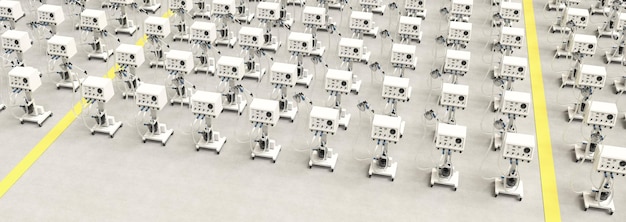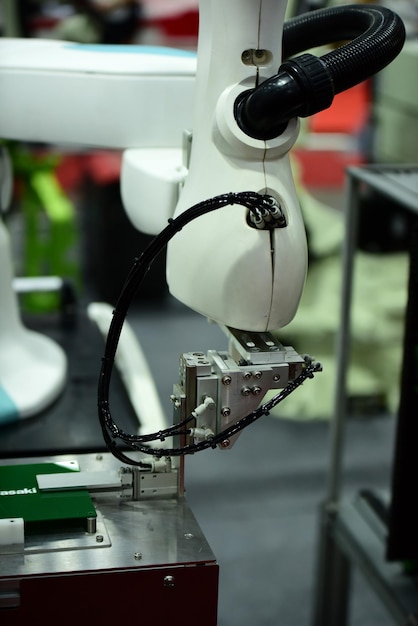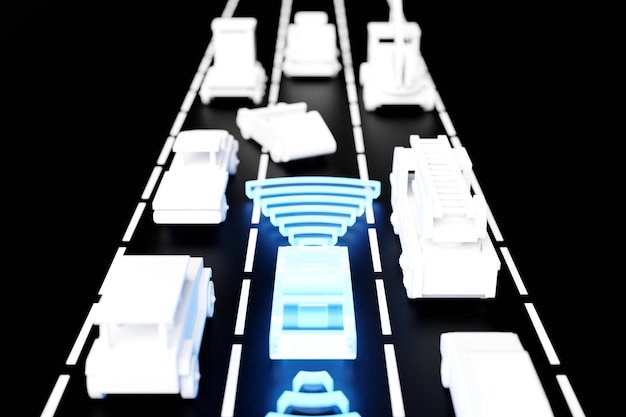Automation’s Impact on US Jobs: Industries at Highest Risk

The Impact of Automation on the US Workforce: Which Industries Are Most at Risk? is significantly reshaping employment landscapes, with sectors like manufacturing, transportation, and customer service facing the greatest potential job displacement due to technological advancements.
The rise of automation is a transformative force reshaping industries across the globe, and the US workforce is no exception. Understanding The Impact of Automation on the US Workforce: Which Industries Are Most at Risk? is crucial for workers, policymakers, and businesses alike.
Automation and the Us Workforce: An Overview
Automation, driven by advancements in artificial intelligence, robotics, and machine learning, is rapidly changing how work is done in the United States. This technological revolution offers numerous benefits, including increased efficiency, reduced costs, and improved productivity. However, it also raises concerns about job displacement and the need for workforce adaptation.
The impact of automation is not uniform across all sectors. Some industries are more susceptible to automation due to the nature of their tasks and the availability of suitable technologies. Identifying these industries and understanding the potential consequences is essential for proactive planning and mitigation strategies.

Manufacturing: A Sector Ripe for Automation
The manufacturing sector has long been at the forefront of automation, and this trend is expected to continue. With repetitive tasks, predictable processes, and a focus on efficiency, manufacturing is particularly well-suited for automation technologies.
Robotics, automated assembly lines, and computer-controlled machines are increasingly replacing human workers in various manufacturing processes. While automation can boost productivity and reduce costs, it also poses a significant threat to manufacturing jobs.
Specific Manufacturing Roles at Risk
- Assembly Line Workers: Tasks involving repetitive assembly and component placement are easily automated.
- Machine Operators: Computer Numerical Control (CNC) machines can perform many tasks previously done by human operators.
- Quality Control Inspectors: Computer vision and AI-powered inspection systems can identify defects more accurately and efficiently.
The shift towards automation in manufacturing requires a focus on retraining and upskilling workers to adapt to new roles that complement automated systems, such as maintenance, programming, and data analysis.
Transportation: The Road to Autonomous Vehicles
The transportation industry is undergoing a significant transformation with the development and deployment of autonomous vehicles (AVs). While the widespread adoption of AVs is still several years away, their potential impact on the transportation workforce is substantial.
Truck drivers, taxi drivers, and delivery drivers are among the occupations most vulnerable to automation in the transportation sector. As AV technology matures and regulatory frameworks evolve, the demand for these roles could decline significantly.

Impact on Different Transportation Roles
- Truck Drivers: Long-haul trucking is a prime target for automation due to its repetitive nature and potential for fuel efficiency gains.
- Taxi and Ride-Sharing Drivers: Autonomous taxis and ride-sharing services could disrupt the traditional taxi industry.
- Delivery Drivers: Automated delivery vehicles and drones could handle last-mile delivery services.
The transition to autonomous transportation will require careful consideration of the social and economic implications, including worker displacement, safety concerns, and infrastructure investments.
Customer Service: Chatbots and Ai Assistants
The customer service industry is increasingly relying on chatbots and AI-powered virtual assistants to handle routine inquiries and provide support. These technologies offer 24/7 availability, cost savings, and consistent service quality.
Customer service representatives, call center agents, and support staff are facing potential job displacement as AI-powered systems become more sophisticated and capable of handling complex customer interactions.
Tasks Being Automated in Customer Service
Chatbots can handle a wide range of customer service tasks, including answering frequently asked questions, providing product information, and resolving simple issues. AI-powered virtual assistants can also personalize customer interactions and offer proactive support.
The integration of AI into customer service requires a focus on training human agents to handle more complex and empathetic interactions that require human judgment and problem-solving skills.
Retail: Self-Checkout and Automated Inventory
The retail industry is adopting automation technologies to improve efficiency, reduce costs, and enhance the customer experience. Self-checkout kiosks, automated inventory management systems, and robotic shelf stockers are becoming increasingly common.
Cashiers, stock clerks, and store associates are among the retail roles most affected by automation. As retailers invest in these technologies, the demand for traditional retail jobs could decline.
Automation in Retail Operations
Self-checkout kiosks allow customers to scan and pay for their purchases without the assistance of a cashier, reducing labor costs and improving checkout speed. Automated inventory management systems use sensors and data analytics to track product levels and optimize stock replenishment. Robotic shelf stockers can navigate store aisles and identify misplaced or out-of-stock items.
The future of retail will likely involve a blend of automation and human interaction, with a focus on creating personalized and engaging shopping experiences.
Administrative Support: Streamlining Processes
Administrative support roles, such as data entry clerks, office assistants, and record keepers, involve many repetitive and rule-based tasks that are easily automated using software and AI-powered tools.
These technologies can streamline administrative processes, reduce errors, and free up human workers to focus on more strategic and creative tasks. However, it also raises concerns about job displacement among administrative support staff.
Specific Administrative Tasks Being Automated
- Data Entry: Optical Character Recognition (OCR) and Robotic Process Automation (RPA) can automate data entry from paper documents.
- Scheduling and Calendar Management: AI-powered scheduling tools can automate meeting arrangements and appointment reminders.
- Document Management: Automated document management systems can organize and track files, reducing the need for manual filing.
The shift towards automation in administrative support requires a focus on upskilling workers to develop skills in areas such as data analysis, project management, and communication.
Agriculture: Technology in the Fields
The agriculture industry is increasingly adopting precision agriculture technologies, such as drones, sensors, and automated machinery, to improve efficiency, reduce waste, and increase crop yields.
Farmworkers, equipment operators, and agricultural laborers are among the roles potentially affected by automation in agriculture. While these technologies can improve productivity and sustainability, they also raise concerns about job displacement in rural communities.
Automation Applications in Agriculture
- Automated Irrigation Systems: Sensors and data analytics can optimize water usage and reduce water waste.
- Robotic Harvesting: Robots can harvest crops more efficiently and accurately than human workers.
- Precision Planting: Automated planting equipment can optimize seed placement and spacing.
The adoption of automation in agriculture requires a focus on training and education to ensure that farmers and farmworkers have the skills needed to operate and maintain these technologies.
| Key Area | Brief Description |
|---|---|
| 🤖 Manufacturing | Automation is transforming assembly lines and machine operations. |
| 🚚 Transportation | Autonomous vehicles threaten driving jobs. |
| 📞 Customer Service | Chatbots handle routine tasks, reducing human roles. |
| 🚜 Agriculture | Automated systems enhance crop management. |
Frequently Asked Questions
▼
Automation involves using technology to perform tasks with minimal human intervention, increasing efficiency and productivity across various sectors.
▼
Jobs involving repetitive tasks or routine operations in industries like manufacturing, transportation, and customer service have high automation potential.
▼
Upskilling and retraining are crucial to transition into roles that complement automated systems, such as programming, maintenance, or data analysis.
▼
Automation improves efficiency, reduces costs, increases productivity, and ensures consistent service quality, driving economic growth and innovation.
▼
Governments can invest in education, training programs, and social safety nets to support workers through the transition to an automated economy.
Conclusion
The Impact of Automation on the US Workforce: Which Industries Are Most at Risk? signals a significant shift in how jobs are structured and performed. While automation brings many benefits, it also presents challenges that require proactive solutions, including workforce retraining, investment in education, and thoughtful policy-making, to ensure a smooth and equitable transition to a more automated future.





